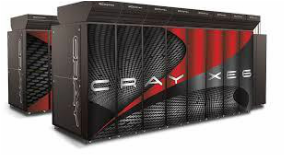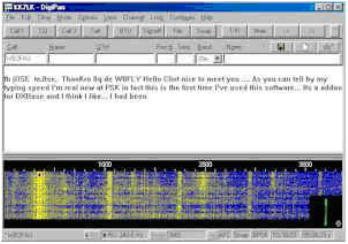Digital Modes Meanderings
The Equipment – Part 1
Another QST article showed me how to build an inexpensive sound card interface. Being a circuit builder, that really piqued my interest and I thought that it might be fun to give it a try. The price certainly was right as I had most of the parts and a metal enclosure in my junk box. Any other required components could be obtained from my local Radio Shack store. The DigiPan software that I would be using to code and decode the PSK signals was available as a free download off the internet. There were many software choices to choose from for digital mode use. Many were free (the magic word for hams!). I only used DigiPan because the QST article recommended it as an easy software choice to setup and use for a digital newbie. That certainly described me. So there was little to lose with any part of this PSK31 foray. I want to say a little bit here about building your own digital mode interface. I like to build circuits and wholeheartedly encourage new hams (and not so new hams) to try their hand at it. Having said that, if you do not have the tools, supplies, or the self-confidence at this time to build your own interface, don’t feel badly about buying a ready-made unit. The time will come when you will want to invest the time and effort to try some self-made (home brew) projects. Meanwhile, enjoy the trip.
Another QST article showed me how to build an inexpensive sound card interface. Being a circuit builder, that really piqued my interest and I thought that it might be fun to give it a try. The price certainly was right as I had most of the parts and a metal enclosure in my junk box. Any other required components could be obtained from my local Radio Shack store. The DigiPan software that I would be using to code and decode the PSK signals was available as a free download off the internet. There were many software choices to choose from for digital mode use. Many were free (the magic word for hams!). I only used DigiPan because the QST article recommended it as an easy software choice to setup and use for a digital newbie. That certainly described me. So there was little to lose with any part of this PSK31 foray. I want to say a little bit here about building your own digital mode interface. I like to build circuits and wholeheartedly encourage new hams (and not so new hams) to try their hand at it. Having said that, if you do not have the tools, supplies, or the self-confidence at this time to build your own interface, don’t feel badly about buying a ready-made unit. The time will come when you will want to invest the time and effort to try some self-made (home brew) projects. Meanwhile, enjoy the trip.
DigiPan screenshot showing the waterfall display
With the homebrew interface built and tested, the DigiPan software downloaded and installed, I was getting anxious to do some PSK31 operations. I need to describe the computer set-up at this point. I was still in the experimentation mode as far as digital sound card modes were concerned. So I was not going to invest heavily in any computer equipment until I was sure that I was going to want to do more of this digital mode stuff. I had just recently acquired a new desktop computer for the household computing needs. That left the old computer free for ham radio use. When I say old, I mean it was very obsolete for 2004. It was a Packard - Bell 233 MHz Pentium machine with a modest 24 MB of RAM and a 3.2 GB hard drive. It still had a 3.5 inch floppy drive, a useless USB 1.0 port and a Windows 95 operating system. But it was available and it did have enough horsepower to get me started. Incidentally, later as I outgrew the DigiPan software and moved up to MixW software, I successfully ran it on this computer set-up for many years. You don’t need a mainframe super computer to run digital mode software. I will add that my Packard-Bell was primarily used as a dedicated computer. Meaning it was mainly used exclusively for just running the digital mode software. It was not absolutely necessary for me to have done that, it was my choice.

<< Super computer not necessary!
The point is that it does not have to cost you and arm and a leg to get started in the digital sound card mode action. Many of these older computers are available free for the taking. Watch the curbs on trash day. I have seen many old computers and monitors sitting on the curb on trash day and some were much newer than my old Packard-Bell. Don’t assume that they all are broken machines. Many are tossed simply due to the fact the owner upgraded their system and just wanted to dump the old one. Even if they have a problem, remember your investment is nothing but a few moments to remove it from the curb. Two or three broken machines may be cobbled together to get one decent running computer. A trip to a local independent computer repair depot may get it up and running with minimum investment. It is worth a try if hobby funds are tight. Remember these words, “Free is good”. The worst thing that could happen is that you may have to put it out on YOUR curb!
<script >
var _gaq = _gaq || [];
_gaq.push(['_setAccount', 'UA-29735940-1']);
_gaq.push(['_trackPageview']);
(function() {
var ga = document.createElement('script'); ga.type = 'text/javascript'; ga.async = true;
ga.src = ('https:' == document.location.protocol ? 'https://ssl' : 'http://www') + '.google-analytics.com/ga.js';
var s = document.getElementsByTagName('script')[0]; s.parentNode.insertBefore(ga, s);
})();
</script>
var _gaq = _gaq || [];
_gaq.push(['_setAccount', 'UA-29735940-1']);
_gaq.push(['_trackPageview']);
(function() {
var ga = document.createElement('script'); ga.type = 'text/javascript'; ga.async = true;
ga.src = ('https:' == document.location.protocol ? 'https://ssl' : 'http://www') + '.google-analytics.com/ga.js';
var s = document.getElementsByTagName('script')[0]; s.parentNode.insertBefore(ga, s);
})();
</script>
